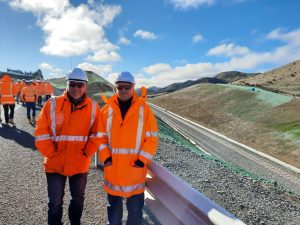Road and rail curves can be costly to maintain so when Tunnel 21 needed repairs following earthquake damage, it made sense to straighten things out.
Vitruvius were engaged by KiwiRail and Waka Kotahi in 2019 to look at options for repairing this key tunnel on the main north line. It had been damaged in both the 2013 Seddon earthquake and subsequent 2016 Kaikoura earthquake. And to make matters more complicated, State Highway One ran straight over the top of it.
“After all the work they had done on North Canterbury Transport Infrastructure Recovery (NCTIR) projects recovering all other sites further south, if this tunnel failed again, it could potentially close the main north line and SH1 down for months,” explains Vitruvius Project Engineer Bryce Hourigan.
“The main challenge was the existing structure was either going to have to be reconditioned, which would be quite costly, or realigned elsewhere. There were several options we looked at for maintaining the existing structure, but they were all pretty expensive. One of the options was to realign around the existing tunnel and that’s what KiwiRail chose to do.”
The new structure is 150m away from the original tunnel and involved realigning both the railway track and state highway. The railway is now 60m shorter and straighter, allowing trains to run at 80km/hr instead of 55km/hr, increasing overall line speed.
“Curves can require a lot of maintenance, especially tight curves. The tunnel itself was on a reasonably tight curve and the lining inside the tunnel showed historic scars from wagons scraping as they go through. That was one of the challenges with the existing tunnel and its alignment. We’ve straightened the alignment up – it now has one less curve and we’re using larger radius curves so it’s more efficient now. It’s also going to require less maintenance in the long run.”
Vitruvius took care of the topographic survey, road and rail geometric design, and digital engineering for this project. A detailed 3D model was built with help from Holmes Consulting, who designed the new tunnel structure, and Tonkin & Taylor who designed the Geotech aspects to design the main rail and road cut. “We basically cut 400,000m³ of dirt out of the hill to realign the rail through that section,” Bryce says.
Vitruvius also provided KiwiRail construction support for setting out the rail track into its final position. The project is particularly significant for the company because it’s the largest 3D model it has built to date and is the first model Vitruvius has done that incorporates both road and rail design (not just rail).
“This project represents a lot of firsts for us. It is pretty impressive to stand on site at the end of it and see the finished result. It’s very rewarding to see how closely it has been constructed to our model. It’s a great illustration of our BIM expertise and how design documentation can be produced ready for construction from a digital model.”
